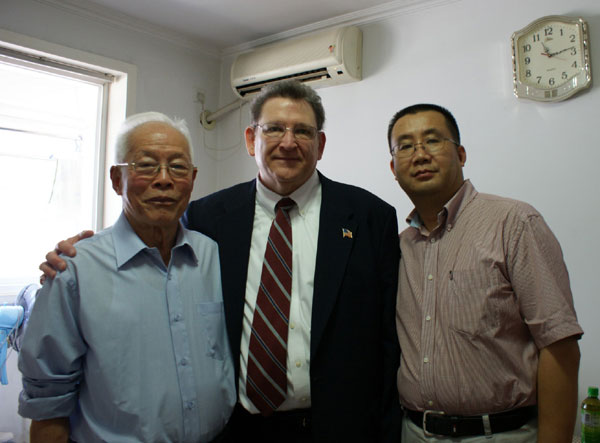 |
| Zhao Zhenying, (left), a 98-year-old nationalist veteran who fought against the Japanese, with Neal Gardner (center) and Yan Huan, who helped to bring Zhao's story to light. CHINA DAILY |
Days after meeting, Neal and Zhao traveled to Nanjing, the Chinese city most traumatized by the Japanese invasion.
On December 13, 1937, Japanese troops embarked on a six-week killing spree in Nanjing. More than 300,000 civilians and disarmed combatants died in what is now known as the Nanjing Massacre, or the Rape of Nanjing. The slaughter shocked the world, and made Nanjing the only real choice as the location for the ceremony of surrender at the end of the war.
"The job of maintaining order and security during the ceremony was given to our battalion to honor our performance during the war," Zhao said. "All my accoutrements-the riding boots, trousers and gloves-were bought after our arrival in Nanjing. It was a moment that would live on in history, and we all knew it.
"To prevent an accidental discharge, our guns were not loaded. Although many people were present, including reporters and observers, I was the only person in the auditorium who was able to move freely," he said.
John Gardner, then aged 31, was also in the hall, and he took a large number of photos to send home.
Later he wrote "The signing of the surrender terms took place on the ninth day of the ninth month at 9 o'clock. Also I left the States on the 9th of September 1943. This is my second anniversary oversees. Gee! I'm excited to get home," he wrote in a letter to his family.
Gardner returned to the US a month later, but not before he had asked his Chinese friends from the CBI to sign his most cherished piece of memorabilia from the war, the little red diary. At the time, he would never have imagined that one day more than half a century later, the photos and the book would help an old man re-establish his identity.
"There are no words in the English or Chinese languages that can describe the feeling one receives when they can help brush aside the dust which covers the past," Neal Gardner said.
Welcoming gifts
On the first page of the diaries that were given to the Allied officers as a "thank-you-and-welcome" gift from the Chinese army, were the words "Merry X'Mas" and "A Victorious New Year".
Before arriving in Beijing to meet Zhao, Neal Gardner and Yan paid a visit to the Tengchong Guoshang Cemetery in Tengchong, Yunnan Province, about 200 kilometers from the China-Myanmar border. The 52-square-meter plot was the site of a series of fierce battles between May and September 1944, as soldiers of the Chinese Expeditionary Forces retook Tengchong, the first town to be recovered from the Japanese army. More than 9,000 Chinese soldiers perished in the battle, along with 19 US Liaison Officers.
"As I felt the rain fall on my head, and as I felt myself get wet, I started to feel that maybe that was how my father had felt..." Neal Gardner wrote, reflecting on his father's experiences in the CBI.
On September 9, 2005, Yan joined the celebration of the 60th anniversary of the Japanese surrender. Zhao watched a live television broadcast in his small apartment in Beijing, and as the historic footage appeared on the screen, he turned to his family and said, "I was there."
Zhao Jingyi, his son, said: "He didn't elaborate, and we all thought he was starting to lose his mind because of his age."
In 2009, a year after Yan first met with Zhao, a friend who made documentaries went to the US National Archives in Washington to search for footage related to China during the war. "I asked him to keep an eye out for anything about the 1945 surrender ceremony, and he brought back some footage," Yan said.
Later, he sat down with a few friends for a private viewing of the footage that had probably not been seen by any Chinese person since it was shot more than five decades before.
The film showed the moments immediately before the ceremony. The camera roamed across the exterior of the auditorium, showing the flags, the giant placard bearing the words "Victory and Peace" in Chinese, and the cars that carried the representatives along the heavily guarded boulevard to the front steps of the auditorium.
Then the camera zoomed in on individual soldiers. They were mostly shown in profile, smiling and making fun of each other. Suddenly, one turned and briefly looked directly into the lens. It was a 28-year-old Zhao, instantly recognizable by his large eyes and high cheekbones.
"The final piece of the puzzle had finally fallen into place," Yan said.
Contact the writer at zhaoxu@chinadaily.com.cn
